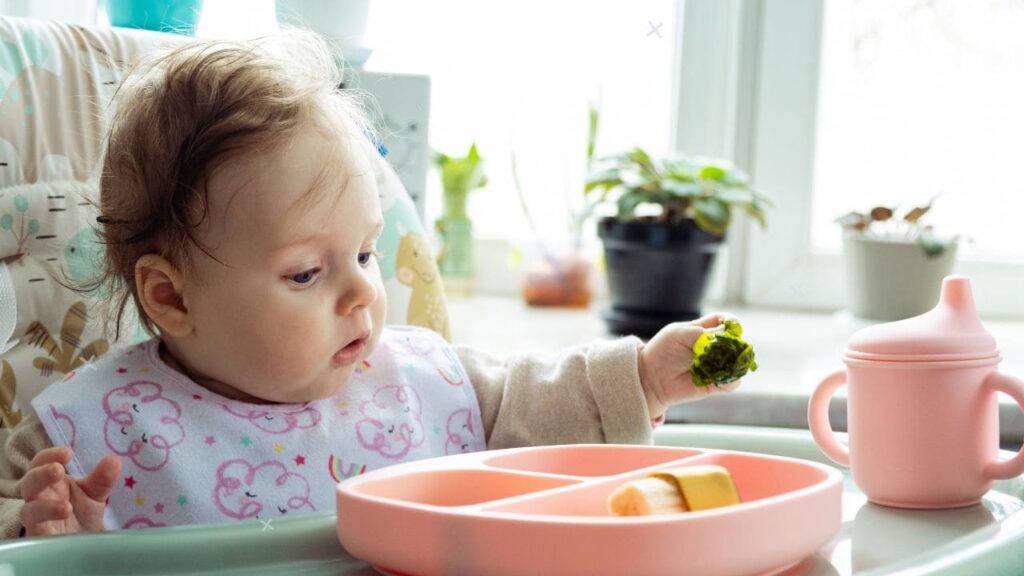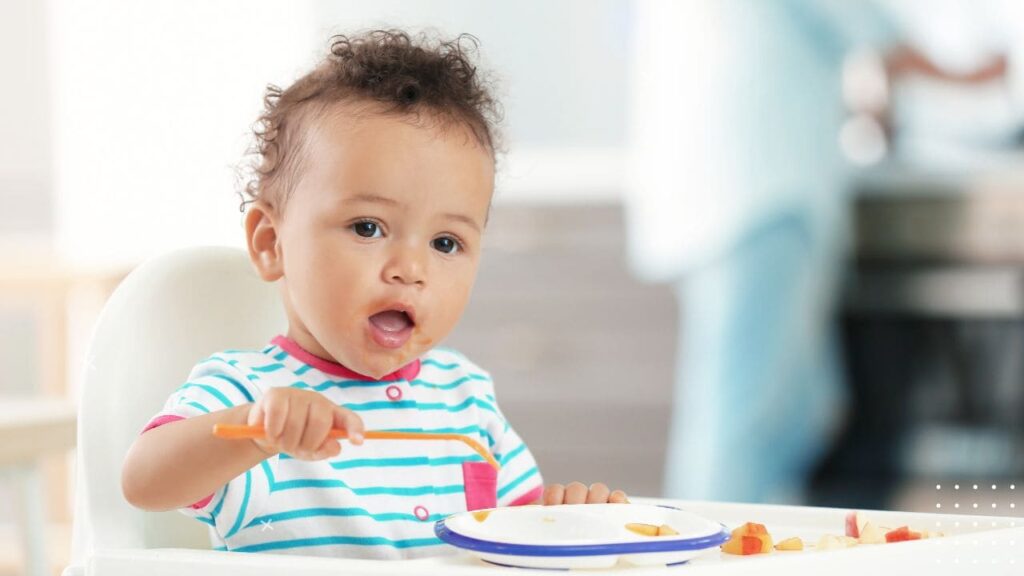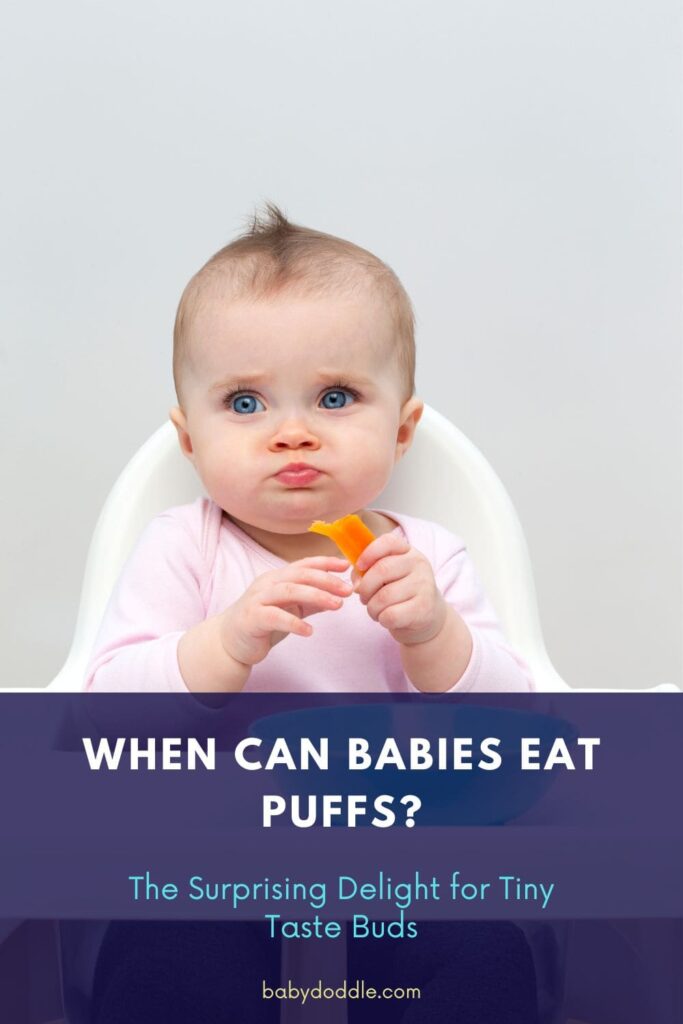Ah, the age-old question that new parents can’t wait to uncover – when can my little one finally dive into the wondrous world of baby puffs? As someone who’s been there, I remember the excitement and uncertainty that came with introducing these delightful snacks to my own bundle of joy. But fear not, fellow parents, for I’m here to guide you through this exciting milestone with all the tips, tricks, and tasty details you need.

What Are Baby Puffs?
Let’s start with the basics – what exactly are baby puffs? These tiny, airy morsels are a popular and convenient snack option for infants and toddlers, designed to be safe, easy to chew, and packed with nutrients. Available in a variety of flavors, from classic rice and sweet potato to more adventurous options like blueberry and cheddar, baby puffs are a go-to for parents looking to expand their little one’s palate.
One of the key features that sets baby puffs apart is their dissolvable texture. Unlike regular snacks, these puffs are formulated to melt easily in a baby’s mouth, reducing the risk of choking and allowing even the tiniest of taste buds to explore new flavors. This makes them an ideal starter food for infants just beginning their solid food journey.
When Can Babies Start Eating Puffs?
Now, the million-dollar question – when can you introduce these delightful puffs to your little one? The answer, as with most things in the world of parenting, is: it depends. The recommended age range for starting baby puffs typically falls between 6-12 months, but there are a few important factors to consider.
First and foremost, it’s crucial to ensure your baby has reached certain developmental milestones before offering puffs. Look for signs that they can sit upright without support, have good head and neck control, and are able to grasp and bring small objects to their mouth. These skills indicate your baby is ready to safely explore the joys of puff-eating.
Signs Baby is Ready for Puffs
- Able to sit upright without support
- Good head and neck control
- Able to grasp and bring small objects to their mouth
- Showing interest in and reaching for food you’re eating
Additionally, it’s recommended to introduce puffs as part of a balanced diet, not as a replacement for breast milk or formula. Puffs should be given at mealtimes, with close supervision to monitor for any potential choking hazards.
Developmental Readiness for Puffs
Babies are typically ready to start exploring puffs between 6-12 months of age. This wide range is due to the varying rates of development among infants. Some key signs that your baby may be ready include:
- Able to sit upright unassisted
- Good hand-eye coordination and pincer grasp
- Showing interest in and reaching for food you’re eating
- Able to move food from the front to the back of the mouth
It’s important to note that the ability to pick up and self-feed puffs isn’t a prerequisite. Many babies can enjoy puffs before mastering the pincer grasp, as long as they demonstrate the other signs of readiness.
| Age Range | Developmental Readiness |
|---|---|
| 4-6 months | – Able to sit upright with support – Showing interest in solid foods |
| 6-9 months | – Able to sit upright unassisted – Developed pincer grasp – Able to move food from front to back of mouth |
| 9-12 months | – Confident in self-feeding< – Chewing and swallowing solid foods with ease |
Pediatric Recommendations
According to the American Academy of Pediatrics, the best time to introduce puffs is around 6 months of age, as part of a varied solid food diet. However, they recommend waiting until 12 months to introduce highly allergenic foods like peanuts, eggs, and shellfish.
By starting puffs around 6 months, you can take advantage of the window when babies are most receptive to trying new flavors and textures. This early exposure can also help shape their developing taste preferences.
Of course, every baby is different, so it’s always best to check with your pediatrician before diving into the world of puffs. They can provide personalized guidance based on your little one’s unique development and health considerations.
Benefits of Puffs for Babies
Now that we’ve covered when to introduce puffs, let’s dive into the exciting world of why these tiny treats are such a great addition to a baby’s diet. Beyond their delicious flavor and enticing texture, puffs offer a host of benefits for your little one’s growth and development.
Nutritional Advantages of Puffs
Baby puffs are typically fortified with essential vitamins and minerals, making them a nutrient-dense snack option. Many varieties contain:
- Iron, which supports healthy red blood cell development and prevents anemia
- Zinc, crucial for immune function and wound healing
- Vitamin B6, important for brain and nervous system health
- Calcium, essential for strong bones and teeth
Not only that, but puffs are often made with whole grains, providing a boost of fiber and complex carbohydrates to fuel your baby’s growing body and brain.
| Nutrient | Benefits |
|---|---|
| Iron | Supports healthy red blood cell development and prevents anemia |
| Zinc | Crucial for immune function and wound healing |
| Vitamin B6 | Important for brain and nervous system health |
| Calcium | Essential for strong bones and teeth |
| Fiber | Promotes healthy digestion and regularity |
| Whole Grains | Provide complex carbohydrates to fuel growth and development |
Motor Skill Development
Believe it or not, those tiny puffs can also play a role in honing your baby’s fine motor skills. The act of picking up, grasping, and bringing puffs to their mouth helps to strengthen the muscles in their hands and fingers, laying the foundation for more advanced dexterity down the road.
Plus, the self-feeding aspect of puffs encourages independent exploration and problem-solving, as your little one discovers the best way to navigate these bite-sized delights.
Sensory Exploration
Introducing puffs also opens up a world of sensory exploration for your baby. The unique texture, shape, and melting sensation can captivate their senses, sparking curiosity and helping them develop a more nuanced understanding of different food experiences.
This early exposure to a variety of tastes and textures can also lay the groundwork for a more adventurous and well-rounded palate as your child grows.
How to Introduce Puffs to Your Baby
Now that we’ve covered the whens and whys of puffs, let’s dive into the hows. Introducing this tasty new snack to your little one doesn’t have to be daunting – with a few simple tips, you can make the process smooth, safe, and even fun.

Preparing Puffs for Baby
When it comes to serving puffs, the key is to choose varieties specifically made for infants and toddlers. These are designed to be easily dissolved in the mouth, reducing the risk of choking. Avoid giving your baby regular, adult-sized snack puffs, as they may pose a larger choking hazard.
It’s also important to start with small portions, gradually increasing the amount as your baby gets more experienced with this new texture. Begin with just a few puffs at a time, and always supervise your little one closely during feeding.
Choosing the Right Puffs
When selecting puffs for your baby, look for varieties that are specifically designed for infants and toddlers. These puffs are formulated to be soft, dissolvable, and free of common choking hazards. Avoid adult-sized or crunchy puff snacks, as they may pose a greater risk.
Some key features to look for in baby puffs include:
- Easily dissolvable texture
- Small, bite-sized pieces
- Made from whole grain, nutrient-dense ingredients
- No added salt, sugar, or artificial flavors
Serving Puffs Safely
When it’s time to serve puffs, start with just a few pieces at a time and monitor your baby closely. Encourage them to take small bites and chew thoroughly before swallowing. Avoid letting them stuff their mouth full of puffs, as this can increase the risk of choking.
It’s also important to always serve puffs when your baby is seated and calm, never while they’re standing, walking, or lying down. This helps ensure they can focus on the task of eating without distractions or increased mobility.
Preparing Puffs at Home
If you’d like to get creative, you can even make your own homemade puff-inspired treats for your baby. Simply blend or process soft, dissolvable ingredients like cooked grains, purees, or even mashed banana, and then dehydrate the mixture into crunchy, puffed bites.
This allows you to control the ingredients and customize the flavors to your little one’s preferences. Just be sure to cut or break the homemade puffs into small, easily dissolvable pieces before serving.
Safe Puff-Eating Practices
To further minimize any choking risks, it’s best to feed puffs to your baby when they’re seated and calm, never while they’re standing, walking, or lying down. Encourage self-feeding, but be ready to step in and assist if needed.
And of course, never leave your baby unattended with a bowl of puffs. Stay nearby and be prepared to jump in if they start to struggle or appear uncomfortable.
Transitioning to New Textures
As your baby masters the art of puff-eating, you can start to introduce them to other soft, dissolvable finger foods. This gradual progression from puffs to more substantial textures will help them develop the chewing and swallowing skills needed for a diverse, nutritious diet.
Remember, every baby is different, so pay close attention to your little one’s cues and signals. If they seem hesitant or uncomfortable with a new food, take a step back and try again another day.

Puffs and Choking Concerns
I know, I know – the dreaded “C” word. Choking is a very real concern for parents when it comes to introducing any new food, and puffs are no exception. But with the right precautions and a little know-how, you can rest assured that your baby can safely enjoy these delightful snacks.
Dissolvability and Choking Risk
One of the key features that sets baby puffs apart is their dissolvable texture. Unlike regular snacks, these puffs are designed to melt easily in a baby’s mouth, reducing the risk of choking and allowing even the smallest of taste buds to explore new flavors.
That said, it’s still essential to supervise your little one closely during puff-eating and to start with small portions. Avoid giving puffs to your baby when they’re in a hurry or distracted, as this can increase the chances of choking.
Preparing Puffs for Safe Consumption
When serving puffs, make sure to break them up into even smaller pieces if needed, and encourage your baby to take their time chewing and swallowing. Avoid letting them stuff their mouth full of puffs, and never leave them unattended with a bowl of the snacks.
If you notice any signs of choking, such as coughing, gagging, or difficulty breathing, immediately stop feeding and call for help. Familiarize yourself with infant choking first aid techniques, just in case.
Recipes and Ideas for Serving Puffs
Now that we’ve covered the when, why, and how of introducing puffs, let’s have a little fun and explore some creative ways to incorporate these tasty treats into your baby’s diet.
Puffs as Part of a Balanced Meal
While puffs make a great snack, it’s important to remember that they shouldn’t replace the essential nutrients found in breast milk, formula, or other solid foods. Serve puffs as part of a balanced meal, pairing them with soft, dissolvable fruits and veggies for a complete and nourishing dining experience.
Try mixing puffs into a fruit puree, or sprinkling them on top of a veggie-packed baby food blend. You can even experiment with making your own homemade puff-inspired treats, like these Carrot and Quinoa Puffs or Apple and Cinnamon Puffs.
Puffs as a Teething Aid
For babies going through the teething phase, puffs can double as a soothing and satisfying snack. The gentle, dissolving texture can provide relief for sore gums, all while offering a nutritious treat.
You can even try freezing puffs for an extra-cooling effect, or pair them with a soft silicone teether for a complete teething-time experience.
Puffs as a Sensory Exploration Tool
Remember how we talked about puffs being a great way for babies to explore new textures and flavors? Well, you can take that a step further by incorporating puffs into sensory play activities.
Try setting up a “puff tray” with different colored or flavored puffs, and let your little one use their fingers to scoop, sprinkle, and discover. Or, mix puffs into a sensory bin alongside other interesting objects for a multi-dimensional exploration session.
The possibilities are endless when it comes to making puffs a fun and engaging part of your baby’s mealtime and playtime routines.
Homemade Puff Recipes
For the truly adventurous parents, why not try your hand at making your own custom puff creations? This allows you to control the ingredients, flavors, and textures to perfectly suit your baby’s preferences.
Try whipping up a batch of Carrot and Quinoa Puffs, blending cooked carrots and quinoa into a smooth puree and then dehydrating it into crunchy, dissolvable bites. Or, for a sweeter treat, experiment with Apple and Cinnamon Puffs, infusing the puffs with the warming spice and natural sweetness of apples.
Puffs as Part of a Balanced
Meal Remember, puffs should never replace the essential nutrients found in breast milk, formula, or other solid foods. Instead, position them as just one component of a well-rounded, balanced meal.
Try mixing puffs into a fruit or vegetable puree, or sprinkling them on top of a hearty baby food blend. This not only adds a fun, textural element to the dish but also ensures your little one is getting a variety of essential vitamins and minerals.
Puffs for Sensory Play
Puffs aren’t just for eating – they can also be a fantastic tool for sensory exploration and discovery. Set up a “puff tray” with different colored or flavored varieties, and let your baby scoop, sprinkle, and investigate to their heart’s content.
You can even incorporate puffs into a larger sensory bin, combining them with other engaging objects like soft blocks, crinkly fabrics, or smooth stones. This multi-sensory experience encourages your little one to use all of their senses to learn about the world around them.
Safety Precautions Recap
As we wrap up our journey through the wonderful world of baby puffs, let’s take a moment to revisit the key safety considerations to keep in mind:
- Choose puffs specifically designed for infants and toddlers, with a dissolvable texture
- Start with small portions and always supervise your baby during puff-eating
- Feed puffs only when your baby is seated and calm, never while standing or moving
- Encourage self-feeding, but be ready to assist if needed
- Never leave your baby unattended with a bowl of puffs
- Familiarize yourself with infant choking first aid techniques, just in case
Remember, the most important thing is to enjoy this exciting milestone with your little one. Puffs can be a delightful and nutritious addition to their diet, but they should never replace the nourishment and comfort of breast milk, formula, or other solid foods.
Conclusion
Ah, the journey of introducing puffs to your baby – it’s a milestone filled with equal parts excitement and a touch of apprehension. But fear not, fellow parents, for with the right guidance and a bit of know-how, you can welcome these tasty treats into your little one’s life with confidence and joy.
From understanding the unique benefits of puffs to mastering the art of safe serving and preparation, we’ve covered all the bases to help you navigate this exciting new chapter. So go forth, conquer the puff-filled world, and savor the surprised delight on your baby’s face as they discover the wonders of this delectable snack.
Happy puff-eating, parents! May your little one’s taste buds be forever captivated by the surprising delights that await.
FAQ – When Can Babies Eat Puffs
When can I start giving my baby puffs?
Most pediatricians recommend introducing puffs to babies around 6-12 months of age, as part of a balanced solid food diet. Babies should demonstrate certain developmental milestones before starting puffs, such as the ability to sit upright unassisted, good hand-eye coordination, and the beginnings of a pincer grasp. Some babies may be ready as early as 6 months, while others may not be ready until closer to 12 months. It’s best to watch for your individual baby’s cues and consult your pediatrician before offering puffs.
Are puffs a choking hazard for babies?
Puffs designed specifically for babies are generally safe, as they are made to dissolve easily in the mouth, reducing the risk of choking. However, it’s still essential to supervise your baby closely when offering puffs and start with just a few pieces at a time. Avoid giving puffs to your baby when they are distracted or moving around, as this can increase the chances of choking. If you have any concerns, consult your pediatrician.
How do I prepare puffs for my baby?
When serving puffs, choose varieties that are formulated for infants and toddlers. These puffs have a soft, dissolvable texture that is easier for babies to manage. Avoid adult-sized or crunchy puff snacks, as they may pose a greater choking risk. Start with just a few puffs at a time, and encourage your baby to take small bites and chew thoroughly before swallowing. Always feed puffs when your baby is seated and calm, never while they are standing or moving around.
What are the benefits of giving my baby puffs?
Puffs offer a variety of benefits for a baby’s growth and development. They are often fortified with essential nutrients like iron, zinc, and vitamin B6, supporting healthy red blood cells, immune function, and brain health. The act of picking up and eating puffs also helps to strengthen a baby’s fine motor skills and hand-eye coordination. Additionally, puffs can provide a fun and engaging sensory experience, exposing your little one to new textures and flavors.
Can I make my own homemade puffs for my baby?
Absolutely! Making your own puff-inspired treats at home can be a fun and customizable way to introduce this snack to your baby. Look for recipes that use soft, dissolvable ingredients like cooked grains, pureed fruits or vegetables, and even mashed banana. Blend or process these ingredients into a smooth mixture, then dehydrate or bake them into crunchy, puffed bites. Just be sure to cut or break the homemade puffs into small, easily manageable pieces before serving to your little one.





